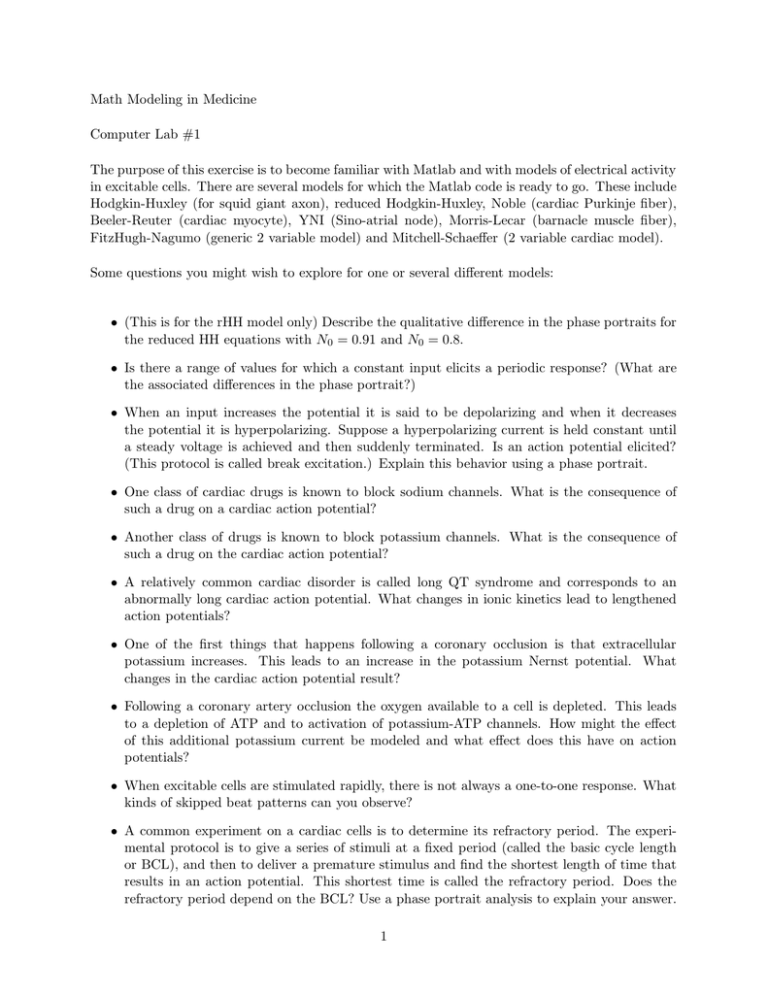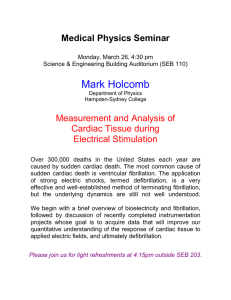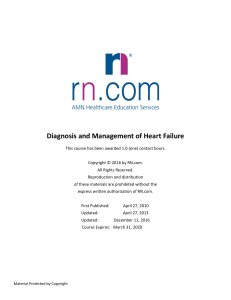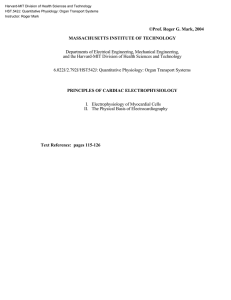Math Modeling in Medicine Computer Lab #1
advertisement

Math Modeling in Medicine Computer Lab #1 The purpose of this exercise is to become familiar with Matlab and with models of electrical activity in excitable cells. There are several models for which the Matlab code is ready to go. These include Hodgkin-Huxley (for squid giant axon), reduced Hodgkin-Huxley, Noble (cardiac Purkinje fiber), Beeler-Reuter (cardiac myocyte), YNI (Sino-atrial node), Morris-Lecar (barnacle muscle fiber), FitzHugh-Nagumo (generic 2 variable model) and Mitchell-Schaeffer (2 variable cardiac model). Some questions you might wish to explore for one or several different models: • (This is for the rHH model only) Describe the qualitative difference in the phase portraits for the reduced HH equations with N0 = 0.91 and N0 = 0.8. • Is there a range of values for which a constant input elicits a periodic response? (What are the associated differences in the phase portrait?) • When an input increases the potential it is said to be depolarizing and when it decreases the potential it is hyperpolarizing. Suppose a hyperpolarizing current is held constant until a steady voltage is achieved and then suddenly terminated. Is an action potential elicited? (This protocol is called break excitation.) Explain this behavior using a phase portrait. • One class of cardiac drugs is known to block sodium channels. What is the consequence of such a drug on a cardiac action potential? • Another class of drugs is known to block potassium channels. What is the consequence of such a drug on the cardiac action potential? • A relatively common cardiac disorder is called long QT syndrome and corresponds to an abnormally long cardiac action potential. What changes in ionic kinetics lead to lengthened action potentials? • One of the first things that happens following a coronary occlusion is that extracellular potassium increases. This leads to an increase in the potassium Nernst potential. What changes in the cardiac action potential result? • Following a coronary artery occlusion the oxygen available to a cell is depleted. This leads to a depletion of ATP and to activation of potassium-ATP channels. How might the effect of this additional potassium current be modeled and what effect does this have on action potentials? • When excitable cells are stimulated rapidly, there is not always a one-to-one response. What kinds of skipped beat patterns can you observe? • A common experiment on a cardiac cells is to determine its refractory period. The experimental protocol is to give a series of stimuli at a fixed period (called the basic cycle length or BCL), and then to deliver a premature stimulus and find the shortest length of time that results in an action potential. This shortest time is called the refractory period. Does the refractory period depend on the BCL? Use a phase portrait analysis to explain your answer. 1 • The simplest model of coupling between cells is to assume that each cell receives an input that is proportional to the difference of potentials between the cells. Build a simulation of two coupled cells that are not identical. Explore the dynamic behavior of these cells. 2










